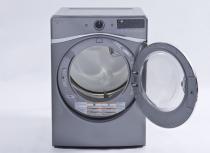How much energy does an Energy Star dryer save?
When you’re shopping for a new clothes dryer you’ll finally see the Energy Star logo on some dryers. Washing machines have long carried the Energy Star but for years dryers used about the same amount of energy and, without impressive differences in energy use, there is no Star. Consumer Reports tested six Energy Star-qualified dryers. Should you buy one? Here’s what you’ll want to know before you decide.
Dryers that qualify
Energy Star dryers can be used in regular or energy-saving mode. To earn the Energy Star a dryer must be at least 20 percent more efficient in energy-saving mode than dryers that meet the federal minimum efficiency standards for 2015.
Superb at drying
Using the regular drying mode all six electric dryers were excellent at drying in Consumer Reports' dryer tests, although none are top picks. Here’s what we tested:
•Whirlpool Duet WED97HEDC, $1,200
•LG DLHX4072V, $1,600
•Maytag Maxima MED7100DW, $1,000
•Whirlpool Duet WED95HEDW, $1,000
•Whirlpool Duet WED87HEDW, $950
•Maytag Maxima MED5100DW, $950
Here’s how they save energy
Moisture sensors have been used in dryers for years and are more accurate than thermostats in determining when laundry is dry. Advanced moisture sensors are one way a dryer can earn the Energy Star, and heat pump technology is another. Unlike washers, dryer manufacturers have fewer variables to manipulate to improve energy efficiency. So it’s low heat and longer drying times or higher heat and shorter drying times.

Energy saved
The Whirlpool Duet WED87HEDW's EcoBoost mode used about 40 percent less electricity, but took 112 minutes to dry our 12-pound load. That’s 38 minutes longer than the regular mode. Your energy savings will vary by the size of the load and what you’re drying. The other dryers extended drying time similarly, except for the LG, which we’re still testing for its potential energy savings. It’s the only heat pump dryer in this group and combines conventional vented drying with a heat pump to cut energy by recycling heat generated during drying.
Money saved
Energy Star says you can save about $20 a year in electricity compared to the dryers you’ll see in stores that meet the minimum efficiency standard. But the longer drying times mean that more air is moving from your home through the vent to outside—air that you may be heating or cooling at a cost. So depending on where you live, the location of the dryer in your home, and the efficiency of your heating and cooling systems, your savings could be quite a bit less.
You’ll see the Energy Star-qualified dryers noted in our clothes dryer Ratings, and find out how they stack up to the dozens of other dryers in performance and price. Look online for utility rebates for Energy Star dryers, and keep in mind that a washer that uses less water and extracts more of it shortens dryer time, saving both energy and money.
—Kimberly Janeway
More from Consumer Reports:
Best tiles for floors, counters and backsplashes
The right vacuum for pets, bare floors and carpets
5 secrets to a long lasting kitchen
Consumer Reports has no relationship with any advertisers on this website. Copyright © 2006-2015 Consumers Union of U.S.

